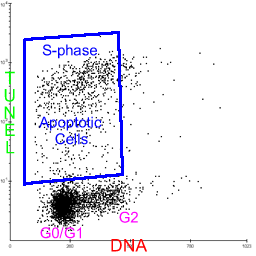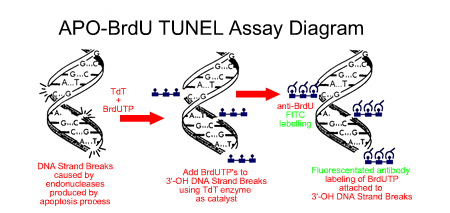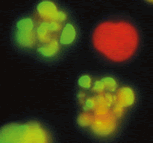Reagents
Download the APO-BrdU protocol booklet here.
Did you know that samples for the APO-BrdU assay can be fixed and then stored in the freezer for an extended period of time before staining?

Anti-colic medication https://singaporemedq.com/metformin-pcos/ flea medicine
About us | Contact us | Ordering | Home


The standard APO-BrdU Kit (AU-1001) is a two color TUNEL (Terminal deoxynucleotide transferase dUTP Nick End Labeling) assay for labeling DNA breaks and total cellular DNA to detect apoptotic cells by flow or image cytometry. It requires a minimum of a two color flow cytometer with a green fluorescence (515nm) and red fluorescence(635nm) detector..
DNA breaks occur late in the apoptotic pathway and are expressed by 95% of cell types. For this reason, the TUNEL assay is called the "gold standard" in apoptosis detection. This kit contains all the instructions and reagents required for measuring apoptosis in cells including; positive and negative control cells for assessing reagent/protocol performance; washing, reaction and rinsing buffers for processing the individual steps of the assay, a fluorescein labeled anti-BrdU antibody for labeling DNA breaks and propidium iodide/RNase A solution for counter staining the total DNA..

The assay will take approximately one hour to stain the cells. In addition, the cells must be paraformaldehyde/ethanol fixed at least one day before staining. The purpose of this is to cross link the DNA so it will not wash out during the staining process. When cells stained with the Apo-BrdU kit are run on the flow cytometer, a dual parameter data display needs be created. One parameter will be apoptosis and the second parameter will be DNA content. This is one of the advantages of the TUNEL assay because not only does it tell you if your cells are apoptotic, but it also tells you where in the cell cycle the cells are apoptotic. No other apoptosis assay does this.
A landmark of cellular self-destruction by apoptosis is the activation of nucleases that degrade the higher order chromatin structure of the DNA into fragments of 50 to 300 kilobases and subsequently into smaller DNA pieces of about 200 base pairs in length. The most consistent hallmark of the apoptotic process, the break-up of the genomic DNA by cellular nucleases, is also one of the easiest and most straightforward to measure (PFS kits take advantage of this fact). As the DNA strands are broken by the nucleases, a large number of 3'-hydroxyl ends of these strand fragments become exposed. This property can be used to identify apoptotic cells by labeling the 3'-hydroxyl ends with bromolated deoxyuridine triphosphate nucleotides (BrdUTP) in the case of the APO-BrdU kit or FITC-dUTPs in the case of the APO-Direct kit. The enzyme terminal deoxynucleotidyl transferase (TdT) catalyzes a template independent addition of the dUTP's to the 3'-hydroxyl ends of double- or single-stranded DNA to blunt, recessed or overhanging ends. A substantial number of these sites are available in apoptotic cells providing the basis for the method utilized in the apoptosis reagent kits from PFS. It has also been established that BrdUTP is more readily incorporated into the DNA break sites of apoptotic cells than are the deoxynucleotide triphosphates complexed to larger ligands like fluorescein, biotin or digoxigenin. This greater incorporation gives rise to the binding of a larger number of fluoresceinated anti-BrdU antibodies to these sites and thus a substantially stronger fluorescent signal from cells labeled in this manner. Below is an illustration of the TUNEL Assay used in the APO-BrdU kit.

In addition, another measurable feature of the cells is easily detected after they have been stained using the TUNEL assay, DNA content. DNA content is measured by adding an intercalating (binds between the double strands of DNA) dye, such as propidium iodide. Why is this important? By combining the TUNEL assay with DNA content, you will discover where in the cell cycle the cells are undergoing apoptosis. Are they apoptotic while in G1, S or G2? This is illustrated below with data from the control cells included with our TUNEL assays. On the X axis of the dual parameter plot is DNA content and on the Y-axis is DNA nick labeling (TUNEL). Since the apoptotic cells are between the G0/G1 population and the G2 population on the DNA axis, they are undergoing apoptosis in S-phase.

Part No. AU-1001
60 Assay Kit plus 5 positive & 5 negative control assays
Contents of the APO-BrdU Kit:
Positive Control Cells
Negative Control Cells
Wash Buffer
Reaction Buffer
TdT Enzyme
Br-dUTP
Rinsing Buffer
Fluorescein-anti-BrdU antibody
Propidium Iodide/RNase DNA staining solution

DNA Breaks (Blebbing)